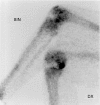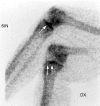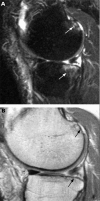Bone scintigraphy in chronic knee pain: comparison with magnetic resonance imaging
- PMID: 10343536
- PMCID: PMC1752758
- DOI: 10.1136/ard.58.1.20
Bone scintigraphy in chronic knee pain: comparison with magnetic resonance imaging
Abstract
Objective: To compare increased bone uptake of 99Tcm-MDP and magnetic resonance (MR) detected subchondral lesions, osteophytes, and cartilage defects in the knee in middle aged people with long-standing knee pain.
Methods: Fifty eight people (aged 41-58 years, mean 50) with chronic knee pain, with or without radiographic knee osteoarthritis, were examined with bone scintigraphy. The pattern and the grade of increased bone uptake was assessed. On the same day, a MR examination on a 1.0 T imager was performed. The presence and the grade of subchondral lesions, osteophytes, and cartilage defects were registered.
Results: The kappa values describing the correlation between increased bone uptake and MR detected subchondral lesions varied between 0.79 and 0.49, and between increased bone uptake and MR detected osteophytes or cartilage defects the values were < 0.54. The kappa values describing the correlation between the grade of bone uptake and the grade of the different MR findings was < 0.57.
Conclusions: Good agreement was found between increased bone uptake and MR detected subchondral lesion. The agreement between increased bone uptake and osteophytes or cartilage defects was in general poor as well as the agreement between the grade of bone uptake and the grade of the MR findings.
Figures





References
Publication types
MeSH terms
Substances
LinkOut - more resources
Full Text Sources
Medical

